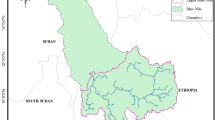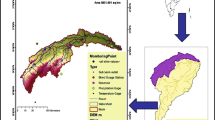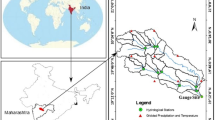Abstract
Modeling efforts on Nestos river are presented. First, the Soil and Water Assessment Tool (SWAT), within a GIS interface (version AVSWATX), was applied to the lower Nestos River basin in Northern Greece. The model was calibrated and verified with the use of field data collected at four monitoring sites along the river course for a period of 3 years (October 2006–October 2009). The performance of the model was evaluated with the use of numerous statistical parameters, which showed a good agreement between the predicted and the observed values. The validated model was then used to test the impact of various management scenarios on the river flow and nutrient loadings. Second, a fuzzy logic model approach was used for the short-term prediction of water depth and chlorophyll-a (Chl-a) in the river according to measured values. The study showed that both the SWAT model and the fuzzy logic technique, if properly calibrated, could be useful and reliable tools in water resources management.















Similar content being viewed by others
References
Altunkaynak A, Ozger M, Cakmakci M (2005) Water consumption prediction of Istanbul city by using fuzzy logic approach. Wat Resour Manag 19:641–654
APHA, AWWA (American Public Health Association, American Water Works Association) (1998) Standard methods for the examination of water and wastewater, 20th Edition, Washington D.C.
Arnold JG, Williams JR, Nicks AD, Sammons NB (1990) SWRRB: a basin scale simulation model for soil and water resources management. Texas A&M University Press, College Station
Arnold JG, Allen PM, Bernhardt G (1993) A comprehensive surface-groundwater flow model. J Hydrol 142(1–4):47–69
Arnold JG, Muttiah RS, Srinivasan R, Allen PM (2000) Regional estimation of base flow and groundwater recharge in the Upper Mississippi river basin. J Hydrol 227(1–4):21–40
Boskidis I, Gikas GD, Pisinaras V, Tsihrintzis VA (2010) Spatial and temporal changes of water quality, and SWAT modeling of Vosvozis river basin, North Greece. J Environ Sci Health-Part A 45(11):1421–1440
Boskidis I, Gikas GD, Sylaios G, Tsihrintzis VA (2011) Water quantity and quality assessment of lower Nestos river, Greece. J Environ Sci Health-Part A 46(10):1050–1067
Coffey AE, Workman SR, Taraba JL, Fogle AW (2004) Statistical procedures for evaluating daily and monthly hydrologic model predictions. Trans ASAE 47(1):59–68
Cotter AS, Chaubey I, Costello TA, Soerens TS, Nelson MA (2003) Water quality model output uncertainty as affected by spatial resolution of input data. J Am Water Resour Assoc 39(4):977–986
Dafis S, Papastergiadou E, Georgiou K, Babalonas D, Georgiadis T, Papageorgiou M, Lazaridou T, Tsiaoussi V (1997) Directive 92/43/EEC: the project “Habitat” in Greece: network natura 2000, life contract B4-3200/84/756, DG XI commission of the European communities. The Goulandris Mouseum of Natural History, Greek Biotope/Wetland Center
Di Luzio M, Mitchell G, Sammons N (2005a) AVSWAT-X short tutorial, Third conference on watershed management to meet water quality standards and emerging TMDL, USA
Di Luzio M, Arnold JG, Srinivasan R (2005b) Effect of GIS data quality on small watershed stream flow and sediment simulations. Hydrol Process 19(3):629–650
FitzHugh TW, Mackay DS (2000) Impacts of input parameter spatial aggregation on an agricultural nonpoint source pollution model. J Hydrol 236(1–2):35–53
Gassman PW, Reyes MR, Green CH, Arnold JG (2007) The soil and water assessment tool: historical development, applications, and future research directions. Trans ASABE 50(4):1211–1250
Gikas GD, Yiannakopoulou T, Tsihrintzis VA (2006a) Water quality trends in a coastal lagoon impacted by non-point source pollution after implementation of protective measures. Hydrobiol 563:385–406
Gikas GD, Yiannakopoulou T, Tsihrintzis VA (2006b) Modeling of non-point source pollution in a Mediterranean drainage basin. Environ Model Assess 11(3):219–233
Gikas GD, Yiannakopoulou T, Tsihrintzis VA (2009) Hydrodynamic and nutrient modeling in a Mediterranean coastal lagoon. J Environ Sci Health-Part A 44(13):1400–1423
Govender M, Everson CS (2005) Modelling streamflow from two small South African experimental catchments using the SWAT model. Hydrol Process 19(3):683–692
Greek Ministry of Agricultural Development (2007) Study on the transportation and distribution of Nestos River water to Xanthi and Komotini plains, aiming at aquifer restoration. Athens (in Greek)
Intergovernmental Panel on Climate Change (IPCC) (2007) Climate change 2007: the physical science basis. Cambridge University Press, Cambridge
Jang JSR (1993) ANFIS: adaptive network-based fuzzy inference system. IEEE Trans Syst, Man Cyberneti 23:665–685
Knisel WG (1980) CREAMS: a field–scale model for chemicals, runoff and erosion from agricultural management systems. Report No. 26. U.S. Department of Agriculture, Science and Education Administration, Conservation Research
Lee HK, Oh KD, Park DH, Jung JH, Yoon SJ (1997) Fuzzy expert system to determine stream water quality classification from ecological information. Water Sci Technol 36:199–206
Leonard RA, Knisel WG, Still DA (1987) GLEAMS: groundwater loading effects on agricultural management systems. Trans ASAE 30(5):1403–1428
Nash JE, Sutcliffe JV (1970) River flow forecasting through conceptual models: part 1 a discussion of principles. J Hydrol 10(3):282–290
Neitsch SL, Arnold JG, Kiniry JR, Williams JR, King KW (2000) Soil and water assessment tool theoretical documentation. Texas Water Resources Institute, Texas
Neitsch SL, Arnold JG, Kiniry JR, Williams JR (2005) Soil and water assessment tool theoretical documentation. Version 2005. Grassland, Soil and Water Research Laboratory, ARS, Texas
Panagopoulos Y, Makropoulos C, Mimikou M (2011a) Diffuse surface water pollution: driving factors for different geoclimatic regions. Water Resour Manag 25(14):3635–3660
Panagopoulos Y, Makropoulos C, Baltas E, Mimikou M (2011b) SWAT parameterization for the identification of critical diffuse pollution source areas under data limitations. Ecol Model 222(19):3500–3512
Papaevangelou VA, Gikas GD, Tsihrintzis VA (2012) Evaluation of evapotranspiration in small on-site HSF constructed wetlands. J Environ Sci Health-Part A 47(5):766–785
Petalas C, Pliakas F, Diamantis I, Kallioras A (2005) Development of an integrated conceptual model for the rational management of the transboundary Nestos River, Greece. Environ Geol 48(7):941–954
Pisinaras V, Petalas C, Gikas GD, Gemitzi A, Tsihrintzis VA (2010) Hydrological and water quality modeling in a medium–sized basin using the Soil and Water Assessment Tool (SWAT). Desalination 250:274–285
Psilovikos A, Margoni S, Psilovikos A (2006) Simulation and trend analysis of the water quality monitoring daily data in Nestos river delta. Contribution to the sustainable management and results for the years 2000–2002. Environ Monit Assess 116(1–3):543–562
Romanowicz AA, Vanclooster M, Rounsevell M, La Junesse I (2005) Sensitivity of the SWAT model to the soil and land use data parametrisation: a case study in the Thyle catchment, Belgium. Ecol Model 187(1):27–39
Sen Z, Altunkaynak A (2004) Fuzzy awakening in rainfall-runoff modeling. Nordic Hydrol 35:31–43
Spiliotis M, Tsakiris G (2007) Minimum cost irrigation network design using interactive fuzzy integer programming. J Irrig Drain Eng 133(3):242–248
Sylaios G, Gitsakis N, Koutroumanidis T, Tsihrintzis VA (2008) CHLfuzzy: a spreadsheet tool for the fuzzy modeling of chlorophyll concentrations in coastal lagoons. Hydrobiol 610:99–112
Sylaios G, Bouchette F, Tsihrintzis VA, Denamiel C (2009) A fuzzy inference system for wind-wave modeling. Ocean Eng 36:1358–1365
Takagi T, Sugeno M (1985) Fuzzy identification of systems and its application to modeling and control. IEEE Trans Syst, Man Cyberneti 15:116–132
Tsakiris G, Spiliotis M (2011) Planning against long term water scarcity: a fuzzy multicriteria approach. Water Resour Manag 25(4):1103–1129
Tsakiris G, Spiliotis M, Paritsis S, Alexakis D (2009) Assessing the water potential of karstic saline springs by applying a fuzzy approach: the case of Almyros (Heraklion, Crete). Desalination 237(1–3):54–64
Tsihrintzis VA, Hamid R (1997) Urban stormwater quantity/quality modeling using the SCS method and empirical equations. J Am Water Resour Assoc 33(1):163–176
Tsihrintzis VA, Hamid R (1998) Runoff quality prediction from small urban catchments using SWMM. Hydrol Process 12(2):311–329
Tsihrintzis VA, Fuentes HR, Gadipudi RK (1996) Modeling prevention alternatives for nonpoint source pollution at a wellfield in Florida. Water Resour Bull 32(2):317–331
USDA-SCS (ed) (1972) National engineering handbook. Hydrology Section 4, Washington DC
van Griensven A, Bauwens W (2003) Concepts for river water quality processes for an integrated river basin modelling. Water Sci Technol 48(3):1–8
van Griensven A, Bauwens W (2005) Application and evaluation of ESWAT on the Dender basin and Wister lake basin. Hydrol Process 19:827–838
Varanou E, Gkouvatsou E, Baltas E, Mimikou M (2002) Quantity and quality integrated catchment modeling under climate change with use of soil and water assessment tool model. J Hydrol Eng 7(3):228–244
Wang X, Melesse AM (2006) Evaluation of the SWAT model’s snowmelt hydrology in a northwestern Minnesota watershed. Trans ASABE 48:1359–1376
Williams JR (1995) The EPIC model, in: Singh VP (ed) Computer models of watershed hydrology. Water Resour Publ pp.909–1000
Wolf AT (1999) The transboundary freshwater dispute database project. Water Int 24(2):160–163
Acknowledgements
The study was funded through an INTERREG IIIA-PHARE CBC Greece-Bulgaria program “A pilot monitoring system of the trans-boundary basin of Nestos river”, Measure 3.2: Protection, Demonstration and Management of the Environment.
Author information
Authors and Affiliations
Corresponding author
Rights and permissions
About this article
Cite this article
Boskidis, I., Gikas, G.D., Sylaios, G.K. et al. Hydrologic and Water Quality Modeling of Lower Nestos River Basin. Water Resour Manage 26, 3023–3051 (2012). https://doi.org/10.1007/s11269-012-0064-7
Received:
Accepted:
Published:
Issue Date:
DOI: https://doi.org/10.1007/s11269-012-0064-7




